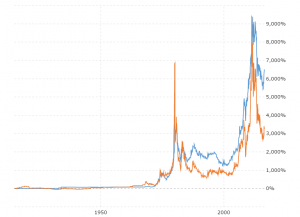Great Britain “The Gold Standard” Coin
With gold prices showing an upsurge because of trade uncertainties, many collectors are looking around to add gold to their collections. The American Eagle and Canadian Maple Leaf gold coins remain top of the list, but it can be worth looking further afield. The Royal Mint, which issues sterling, the currency of the United Kingdom, is a world-class mint, with high standards and 100% reliable products, so one can always buy from them with confidence.
A new coin from the Royal Mint is not only a way to add some gold to your collection, but has, in its design, an interesting and relevant theme that makes it particularly appropriate to collectors of gold, many of whom believe that the ‘days when gold was king’ were the best of days. This coin commemorates the Gold Standard, the way in which money was once given a more solid footing than the reputation and economic strength of the issuing country.
First the coin. the Royal Mint 1/4 oz Gold Standard £25 coin is 7.775 grams (1/4 troy ounce) of pure gold, in a coin of 99.99% purity. It has a diameter of 22.05 mm (0.86 of an inch), and it bears the standard obverse design found of all UK coins. This is a profile bust of Queen Elizabeth II, the fifth such profile since her coronation in 1953, and created by Mint designer Jody Clarke. The surface behind the bust has an all-over pattern of fine squares in arcs, which is called a guilloche pattern. This is designer to discourage counterfeiting. The inscriptions, ELIZABETH II D.G. REG. F.G., AND 25 POUNDS, surround the bust.
The reverse is a unique design featuring a set of scales such as might have been used to weight gold, with a circular measuring instrument behind it. The inscriptions, ¼ OZ FINE GOLD, 999.9, THE GOLD STANDARD, the year of issue, and the engraver’s initials – DME, appear on this side.
The Gold Standard was a method to maintain the value of currency based on the use of gold as the ultimate medium of exchange. It was legal for a holder of a bank note to present at the bank and receive it value in gold. International trade transactions were also settled in gold, which was moved around from country to country. This meant that trading nations with big exports could accumulate large quantities of gold, while nations wishing to buy their good had to build up sufficient reserves to pay for them. Britain was the first country to adopt the Gold Standard, in 1821 – although of course gold had been used for trade for centuries. With its enormous global trade, this allowed Britain to accumulate vast wealth. The system became international when adopted by Germany in 1871, and by 1900 it was almost universal. With its enormous reserves of silver, America was reluctant to join it, since they would be disadvantaged, but they did eventually join.
The system worked well for trade until the outbreak of World War I, when American banks became financiers of the British and French, with American dollars. It did continue for some years, but smaller nations, lacking much gold, began to use US dollars and British sterling pounds for trade, ignoring gold. In 1931 Britain suspended its use, leaving just France and the USA on the Gold Standard. Then the US raised the exchange rate, from $20.67/oz to $35.00/oz, which sharply devalued the dollar, but brought a flood of gold into the country, cornering the market. After WWII the Bretton Woods Agreement effectively made the US dollar the standard for international trade, and by 1968 gold was freely traded, and currencies were no longer tied to it at a fixed rate. The Gold Standard was dead.
















